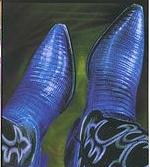 mar. 10 mai 2005, 22:09 mar. 10 mai 2005, 22:09
Message
#1
|
|
|
Rookie  Groupe : Members Messages : 43 Inscrit : 05 juin 04 Lieu : Paris - FR Membre no 44,558 |
comment, enregistré dans dp un standalone, je sais que c'est possible, c'est dans le manuel...mais j'y arrive pas...
cela me permetrai de connecté par exempl battery et d'avoir les pistes separé (qui ne foncionnent pas en format plugin...) je copie le manuel: QUOTE Stand-alone Virtual Instruments A stand-alone virtual instrument is one that runs as a separate application, side by side with Digital Performer (instead of as a plug-in running inside Digital Performer). Digital Performer does not require any additional preparation for use with CoreMIDI-compatible virtual instruments. (CoreMIDI is the under-the-hood portion of Mac OS X that handles MIDI services for MIDI hardware and software.) If a virtual instrument operates as a separate application, run it concurrently with Digital Performer, and any MIDI inputs and outputs that it publishes to CoreMIDI will appear in Digital Performers MIDI input and output menus. Similarly, the instrument's audio outputs will appear in the input menus of Digital Performer's audio tracks. If the virtual instrument supports ReWire, then it uses the ReWire protocol to exchange MIDI and audio data with Digital Performer. If the virtual instrument operates as a plug-in inside Digital Performer, open it as described in Virtual Instrument Plug-ins. When you open the plug-in, its MIDI inputs and outputs appear in Digital Performers MIDI I/O menus. Interapplication MIDI Most applications that share MIDI input and output with Digital Performer publish their own virtual MIDI inputs and outputs, which automatically appear in Digital Performers MIDI input and output menus. Most of the time, you can use the inputs and outputs provided by these other applications. There may be times, however, when other applications require Digital Performer to publish inputs and outputs. Use the Interapplication MIDI window (Setup menu) to create them. Click the Add buttons to create an input or output. To rename them, double-click the name. To remove an input or output, click it and click Delete. Each input or output acts like a virtual MIDI cable, providing sixteen MIDI channels. Inputs appear by name in any menu in Digital Performer that displays MIDI inputs; outputs appear by name in any Digital Performer menu that displays MIDI outputs. For example, if you wish to send data from a Digital Performer MIDI track to another application, assign the tracks output to a Digital Performer MIDI output. Digital Performers interapplication MIDI inputs and outputs are published to all MIDI applications that support the Mac OSs built-in MIDI services. A Digital Performer output appears as an input in other applications; conversely, a Digital Performer input appears as an output to other applications. alors quelqu1 peut m'aider? merci d'avance |
|
|
|
 |
Réponse(s)
 mer. 11 mai 2005, 14:15 mer. 11 mai 2005, 14:15
Message
#2
|
|
 Junior Member    Groupe : Members Messages : 173 Inscrit : 21 avril 04 Lieu : Paris - FR Membre no 41,532 |
Je ne connais pas battery mais normalement tu doit retrouver les sorties de ton instrument virtuel sur les entrées de tranches de ta fenêtre "console de mixage".
-------------------- Les cloisons ça vous fait des générations de taupes
G5 2x1,8 PPC , 2,25Go Ram, DP5.13 |
|
|
|
Les messages de ce sujet
  |
1 utilisateur(s) sur ce sujet (1 invité(s) et 0 utilisateur(s) anonyme(s))
0 membre(s) :













